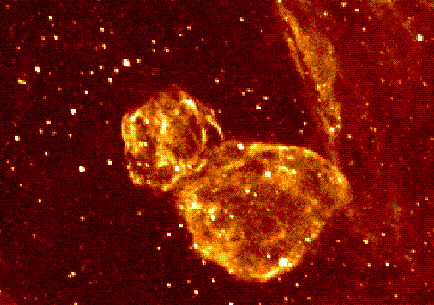Explanation: When a massive star exhausts its nuclear fuel it explodes. This stellar detonation, a supernova, propels vast amounts of starstuff outwards, initially at millions of miles per hour. For another 100,000 years or so the expanding supernova remnant gradually slows as it sweeps up material and ultimately merges with the gas and dust of interstellar space. Short lived by cosmic standards, these stellar debris clouds are relatively rare and valuable objects for astronomers exploring the life cycles of stars. Yet this double bubble-shaped nebula 160,000 light-years away in the Large Magellanic Cloud may represent something rarer still - the collision of two supernova remnants. This image in the light of excited Hydrogen atoms along with images at X-Ray, radio and other optical wavelengths, suggests that the bubbles are indeed two separate regions of hot gas surrounded by cooler dense shells begining to interact as they expand and make contact.
1999 2000 2001 2002 2003 2004 2005 2006 2007 2008 2009 2010 2011 2012 2013 2014 2015 2016 2017 2018 2019 2020 2021 2022 2023 2024 2025 |
Yanvar' Fevral' Mart Aprel' Mai Iyun' Iyul' Avgust Sentyabr' Oktyabr' Noyabr' Dekabr' |
NASA Web Site Statements, Warnings, and Disclaimers
NASA Official: Jay Norris. Specific rights apply.
A service of: LHEA at NASA / GSFC
& Michigan Tech. U.
|
Publikacii s klyuchevymi slovami:
nebula - remnants - LMC - supernova remnant - supernova - Evolyuciya zvezd - Sverhnovye - ostatok Sverhnovoi
Publikacii so slovami: nebula - remnants - LMC - supernova remnant - supernova - Evolyuciya zvezd - Sverhnovye - ostatok Sverhnovoi | |
Sm. takzhe:
Vse publikacii na tu zhe temu >> | |
